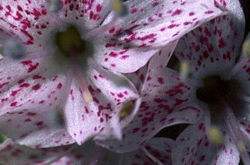Brandon E Campitelli, Amanda M Kenney, Robin Hopkins, Jacob Soule, John T Lovell, Thomas E Juenger; Genetic mapping reveals an anthocyanin biosynthesis pathway gene potentially influencing evolutionary divergence between two subspecies of scarlet gilia (Ipomopsis aggregata), Molecular Biology and Evolution, msx318, https://doi.org/10.1093/molbev/msx318
Milano, E., Kenney, A. and T.E. Juenger. 2016. Adaptive differentiation in floral traits in the presence of high gene flow in scarlet gilia (Ipomopsis aggregata). Molecular Ecology 25: 5862-5875.
Stearns, F, Boles, S, Hurston, H., Vo, T., Butler, D., Shuham, W. and T. Juenger. 2008. Identification of nuclear microsatellite loci for Ipomopsis aggregate and the distribution of pairwise relatedness in a natural population. Molecular Ecology Resources 8: 437-439.
Juenger, T., Morton, T.C., Miller, R.E., and J. Bergelson. 2005. Scarlet gilia resistance to insect herbivory: the effect of early season browsing, plant apparency, and phytochemistry on patterns of seed fly attack. Evolutionary Ecology 19: 79-101.
Juenger, T. and J. Bergelson. 2000. The evolution of compensation to herbivory in scarlet gilia, Ipomopsis aggregata; herbivore-imposed natural selection and the quantitative genetics of tolerance. Evolution 54: 764-777.
Juenger, T. and J. Bergelson. 2000. Factors limiting rosette recruitment in scarlet gilia, Ipomopsis aggregata: seed and microsite limitation. Oecologia 123: 358-363.
Juenger, T. and J. Bergelson. 1999. Does early season browsing influence the effect of self-pollination in scarlet gilia? Ecology 81: 41-48.
Juenger, T. and J. Bergelson. 1998. Pairwise and diffuse natural selection and the multiple herbivores of scarlet gilia, Ipomopsis aggregata. Evolution 52: 1583-1592.
Juenger, T. and J. Bergelson. 1997. Resource and pollen limitation of compensation to herbivory in scarlet gilia, Ipomopsis aggregata. Ecology 78: 1684-1695.
Bergelson, J., Juenger, T. and M.J. Crawley. 1996. Regrowth following herbivory in Ipomopsis aggregata: compensation but not overcompensation. The American Naturalist 148: 744-755.


